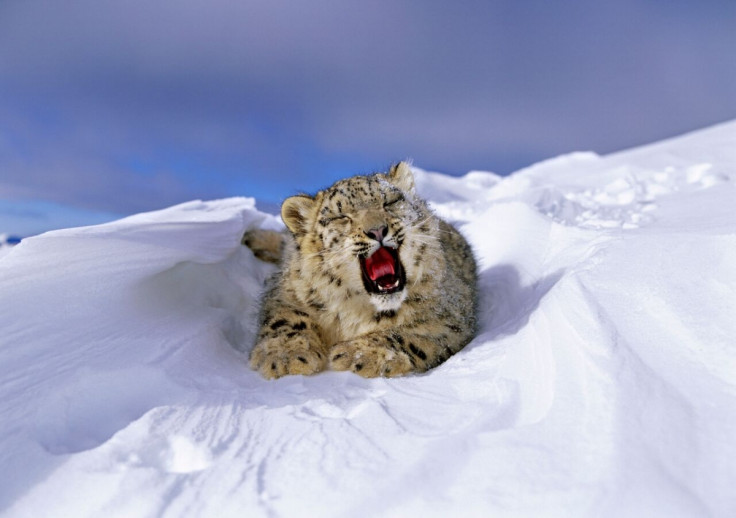COP21: How climate change is affecting the already endangered snow leopard

We don't really know how many snow leopards there are left. The current estimates put the population between 4,000 and 6,500 but we can't be sure. The snow leopard is so elusive, so solitary, attempts to work out numbers have tended to end with ballpark figures, rather than anything concrete. Even if they were more accurate, the figures are generally old. One thing we can say about snow leopards is that the numbers are decreasing and climate change is going to affect them more and more.
According to the International Union for Conservation of Nature's Red List of Threatened Species, the snow leopard is, quite simply, endangered. They've kept that status for some time, at least since 1986, but in the years between 1992 and 2008 their population is estimated to have decreased by 20%.
Snow leopards live between 12 countries: Afghanistan, Bhutan, China, India, Kazakhstan, Kyrgyzstan, Mongolia, Nepal, Pakistan, Russia, Tajikistan and Uzbekistan. They live in high alpine, mountainous regions, places where their fur helps to camouflage them when they're out hunting ibex and blue sheep. They're called snow for a reason (though, panthera uncia, if you want the scientific name).
Snow leopards have two major threats to their survival: poachers and retaliatory killings by local communities when snow leopards attack their livestock. It's the second one that's going to get worse with climate change.

Poaching is still a problem, as John Barker, head of programmes India and China for WWF UK, told IBTimes UK, though it depends on the country. In Nepal and the Himalayas there's not as much poaching thanks to the snow leopards' innate ability to stay unseen and stay solitary. "There is a market still for snow leopard pelt and bones in some of the illegal trade in the East" says Barker. In China, "poaching has been a significant issue".
But the way climate change affects the snow leopard's life is twofold, both of which end with the same issue. As mountain temperatures rise and the snow line retreats, the forest level moves up. The snow leopard's natural habit reduces, as does the habitat of its usual prey. When their prey becomes more scarce, they are more likely to attack domestic livestock and reap retaliation from farmers for killed livestock.
As the forest line moves up, the area that humans are able to move into also increases. Again, as farms move closer to snow leopard territory, the more likely the snow leopards are to attack domestic livestock and, again, feel the retaliation of local communities. As Barker said, it's with these factor that "the human/wildlife conflict starts to rear its head".
As with the Sami people in northern Scandinavia, snow leopards and other wildlife and people that rely on the local ecosystem, are finding that the natural world around them is changing thanks to industry and unsustainable practice that they never instigated or had a part in. Similarly, the decisions taken at the UN's Conference of Parties (COP21) in Paris, when delegates from 196 countries will decide on how the world will tackle climate change, will be decided without their input. Even if COP21 ends up with an agreement that stops global temperatures rising more than 2C above pre-industrial levels (this is thought to be incredibly unlikely), a 2C change will still have its effect on the snow leopard's habitat.
The WWF plans its programmes to align with the Global Snow Leopard & Ecosystem Protection Program – "The basis of that programme is to establish 20 connected snow leopard landscapes each with more than 100 breeding animals, which in itself only sounds like 2,000 animals but we're talking about connected landscapes and animals that are able to breed" says Barker, WWF wants its programmes to "ensure not just the protection of snow leopards but the landscapes they live in, particularly in a world of changing climate."

There's not a lot of area left for snow leopards and according to WWF, a third of snow leopard habitats are at threat from climate change. "You either run out of mountain or the animals start running into issues, as it gets higher, of not being able to go any higher themselves because of oxygen levels."
"It's not just about protecting the species, it's about protecting the habitat, ensuring the habitat they live in and people live in is sustainably managed and the benefits of those habitats go both to the biodiversity that lives there and the people that live there as well."
We've known about these issues for a while now. WWF has been working with communities in Nepal for at least 15 years, in places like Kangchenjunga, populations have even started to increase. In Afghanistan too, where the war has kept people from doing so much in snow leopard territory, numbers are starting to rise.
But issues caused by climate change will get worse as the temperature continues to rise and governments elsewhere watch on. If we want to help keep snow leopards part of our planet, we will need a new approach to greenhouse gases and mitigating climate change.
The talks start on 30 November and continue until 11 December.
© Copyright IBTimes 2025. All rights reserved.






















